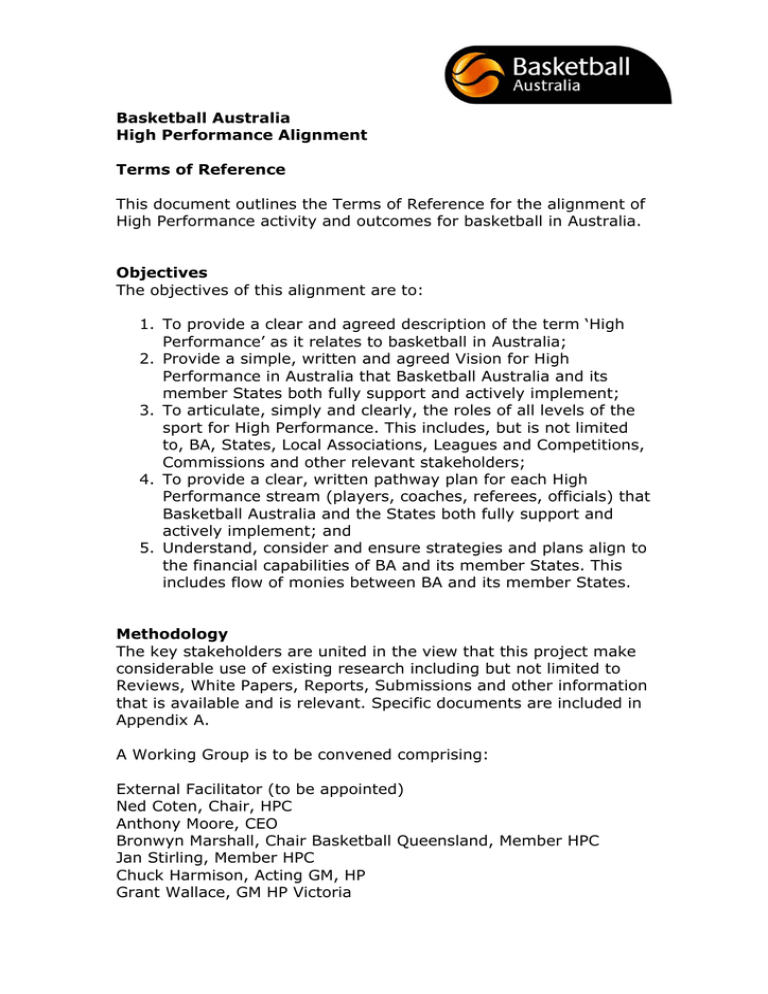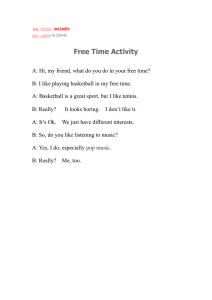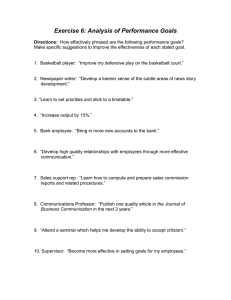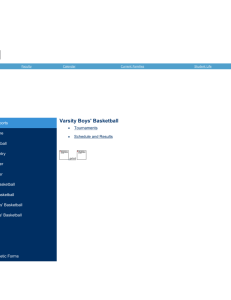High Performance Alignment
advertisement

Basketball Australia High Performance Alignment Terms of Reference This document outlines the Terms of Reference for the alignment of High Performance activity and outcomes for basketball in Australia. Objectives The objectives of this alignment are to: 1. To provide a clear and agreed description of the term ‘High Performance’ as it relates to basketball in Australia; 2. Provide a simple, written and agreed Vision for High Performance in Australia that Basketball Australia and its member States both fully support and actively implement; 3. To articulate, simply and clearly, the roles of all levels of the sport for High Performance. This includes, but is not limited to, BA, States, Local Associations, Leagues and Competitions, Commissions and other relevant stakeholders; 4. To provide a clear, written pathway plan for each High Performance stream (players, coaches, referees, officials) that Basketball Australia and the States both fully support and actively implement; and 5. Understand, consider and ensure strategies and plans align to the financial capabilities of BA and its member States. This includes flow of monies between BA and its member States. Methodology The key stakeholders are united in the view that this project make considerable use of existing research including but not limited to Reviews, White Papers, Reports, Submissions and other information that is available and is relevant. Specific documents are included in Appendix A. A Working Group is to be convened comprising: External Facilitator (to be appointed) Ned Coten, Chair, HPC Anthony Moore, CEO Bronwyn Marshall, Chair Basketball Queensland, Member HPC Jan Stirling, Member HPC Chuck Harmison, Acting GM, HP Grant Wallace, GM HP Victoria David Ingham, GM HP SA Greg Hill, BA CFO Gavin McDonald, Lead - Governance & Business development, ASC Toni Cumpston, Performance Manager, Performance Excellence, AIS The Working Group should review this information and other relevant information which it finds in the course of its duties to assist in developing a view of the future. Further, the Working Group should engage with specific Stakeholders, including but not limited to: - States (including CEO, Chair and HP lead) – In person; - BA Centre of Excellence – In person; - Australian Sports Commission – In person; - High Performance coaches at State and Association level (via online survey); - State Institutes of Sport (where relevant); - BA High Performance Commission Members; and - Greg Hill, BA CFO, specifically in relation to financial implications of the plan. The Working Group should then collate and discuss the insights from this information in order to make recommendations. Informal discussion between BA and its member States has highlighted areas that are of concern currently and should be considered: - Collaboration; - Better utilising existing resources; - Better utilising existing infrastructure; and - Communication. Scope The Scope is broken into two Stages and should include consideration of the following: Stage 1 Participant Base - Clearly define the pathway from Junior Elite level through to National representative level so that that participants, Administrators and stakeholders (for example parents) are clear on what happens in what order and who is responsible. This consideration should include participants involved at the following levels of the sport: o Association Junior representative level or equivalent (for - example participating in the VJBL in Victoria, WABL in WA etc); o Association Senior representative level (for example participating in State League competition); o State representative level (for example National Championships, National Schools Championships etc); o National Intensive Training programs and equivalent; and o Elite competitions (NBL, WNBL, SEABL, NWBL, WNWBL) Participants in all vocations, including players, coaches, referees and technical officials (Scorebench, Statisticians). Location -­‐ Centralised versus decentralised at both State and national level; -­‐ Location for centralised, define criteria; and -­‐ Current Centre of Excellence program. Financial -­‐ Clear understanding of total financial inputs across system currently; -­‐ Budget allocation from BA & States – percentage contribution to HP; and -­‐ Immediate future of ASC funding, including timing and windows. Communication -­‐ Responsibility and accountabilities between the stakeholders; -­‐ Dissemination of best practice learning; and -­‐ Calendar of events and activities – published. Pathway -­‐ Clear pathway from junior to national teams (city and country); and -­‐ Role of BA, States, Local Associations, schools and other relevant stakeholders. Staffing -­‐ Staff allocation across chosen model; -­‐ Requirement for a Basketball Australia National Coaching Manager role; and -­‐ Role of BA GM HP and relationship with State HP Managers; Stage 2 Third Party Providers -­‐ Interaction and engagement with private Academy’s; -­‐ Interaction and engagement with US High Schools & College system; 3 on 3 -­‐ Consideration of existing 3x3 programs; -­‐ BA and State responsibilities & priorities; -­‐ Competition structure; and -­‐ High performance priorities. Participant Base - Participants in all streams including Able-bodied, disabled and ID participants. Financial -­‐ Long-term future of ASC funding, including timing and windows. Communication -­‐ Published HP Plan; and -­‐ Professional Development for participants at all levels. Findings The Findings for Stage 1 should be presented to Basketball Australia and its member States jointly by December 15, 2015. The findings for Stage 2 should be presented by May 2016. In both cases, this should be in the form of a written report supported with a verbal presentation at the appropriate time.




